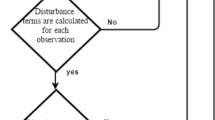Abstract
The recurrent fuzzy time series function method can be obtained in two ways. First is using a similar model to the autoregressive moving average to obtain fuzzy functions and the second one is using recurrent connections in the combining equation. The recurrent structure provides less number of inputs and more accurate forecasts. The contribution of the paper is proposing a recurrent fuzzy time series function method and its bootstrapped version. The recurrent models are used to obtain fuzzy functions in the proposed method. The classical bootstrap method is applied and bootstrap samples are generated from learning samples. The bootstrap method provides lower forecast error variance for the proposed method. The performance of new methods is compared with some fuzzy function methods and classical approaches. First, Turkey electrical consumption data time series are analyzed. Second, the Australian beer consumption time series are analyzed. As a result of applications, new methods have good forecasting performance if compare to established benchmarks.




Similar content being viewed by others
References
Aladag CH, Yolcu U, Egrioglu E, Turksen IB (2016) Type-1 fuzzy time series function method based on binary particle swarm optimization. Int J Data Anal Tech Strateg 8(1):2–13
Bas E, Egrioglu E, Yolcu U, Grosan C (2019) Type 1 fuzzy function approach based on ridge regression for forecasting. Granular Comput 4(4):629–637
Bas E, Yolcu U, Egrioglu E (2020) Picture fuzzy regression functions approach for financial time series based on ridge regression and genetic algorithm. J Comput Appl Math. https://doi.org/10.1016/j.cam.2019.112656
Baser F, Demirhan H (2017) A fuzzy regression with support vector machine approach to the estimation of horizontal global solar radiation. Energy 123:229–240
Beyhan S, Alci M (2010) Fuzzy functions based ARX model and new fuzzy basis function models for nonlinear system identification. Appl Soft Comput 10(2):439–444
Bezdek JC (1981) Pattern recognition with fuzzy objective function algorithms. Plenum Press, NewYork
Box GEP, Jenkins GM (1976) Time series analysis: Forecasting and control. San Francisco: Holden-Day
Çelikyılmaz A, Turksen IB (2007) Fuzzy functions with support vector machines. Inf Sci 177:5163–5177
Çelikyılmaz A, Turksen IB (2008a) Enhanced fuzzy system models with an improved fuzzy clustering algorithm. IEEE Trans Fuzzy Syst 16:779–794
Çelikyılmaz A, Turksen IB (2008b) Uncertainty modelling of improved fuzzy functions with evolutionary systems. IEEE Trans Syst Man Cybern 38:1098–1110
Chen SM, Chen CD (2011) Handling forecasting problems based on high-order fuzzy logical relationships. Expert Syst Appl 38(4):3857–3864
Chen SM, Hsu CC (2008) A new approach for handling forecasting problems using high-order fuzzy time series. Intell Autom Soft Comput 14(1):29–43
Chen SM, Jian WS (2017) Fuzzy forecasting based on two-factors second-order fuzzy-trend logical relationship groups, similarity measures and PSO techniques. Inf Sci 391–392:65–79
Chen S, Wang N (2010) Fuzzy forecasting based on fuzzy-trend logical relationship groups. IEEE Trans Syst Man Cybern Part B (Cybernetics) 40(5):1343–1358
Chen SM, Zou XY, Gunawan GC (2019) Fuzzy time series forecasting based on proportions of intervals and particle swarm optimization techniques. Inf Sci 500:127–139
Dalar AZ, Egrioglu E (2018) Bootstrap Type-1 fuzzy functions approach for time series forecasting. Trends and perspectives in linear statistical inference. Springer, New York, pp 69–87
Egrioglu E, Aladag CH, Yolcu U, Bas E (2014) A new adaptive network based fuzzy inference system for time series forecasting. Aloy J Soft Comput Appl 2:25–32
Hathaway RJ, Bezdek JC (1993) Switching regression models and fuzzy clustering. IEEE Trans Fuzzy Syst 1(3):195–203
Janacek G (2001) Practical time series. Oxford University Press Inc, Oxford
Jang JSR (1993) ANFIS: adaptive network based fuzzy inference system. IEEE Trans Syst Man Cybern 23(3):665–685
Kizilaslan B, Egrioglu E, Evren AA (2020) Intuitionistic fuzzy ridge regression functions. Commun Stat Simul Comput. https://doi.org/10.1080/03610918.2019.1626887
Mamdani EH, Assilian S (1981) An experiment in linguistic synthesis with a fuzzy, logic controller. In:L E.H. Mamdani, B.R. Gains (Eds.), Fuzzy Reasoning and Its Applications, Academic Press, New York, 311–323.
Rumelhart E, Hinton GE, Williams RJ (1986) Learning internal representations by error propagation, The M.I.T. Press, Cambridge, Chapter 8, 318–362
Tak N (2020) Type-1 recurrent intuitionistic fuzzy functions for forecasting. Expert Syst Appl 140:112913
Tak N, Evren AA, Tez M, Eğrioğlu E (2018) Recurrent Type-1 fuzzy functions approach for time series forecasting. Appl Intell 48:68–77
Takagi T, Sugeno M (1985) Fuzzy identification of systems and its applications to modelling and control. IEEE Trans. Syst. Man Cybern., SMC-15 (1), 116–132.
Turksen IB (2008) Fuzzy functions with LSE. Appl Soft Comput 8(3):1178–1188
Yolcu OC, Bas E, Egrioglu E, Yolcu U (2019) A new intuitionistic fuzzy functions approach based on hesitation margin for time series prediction. Soft Comput. https://doi.org/10.1007/s00500-019-04432-2.789
Zadeh LA (1975) The concept of a linguistic variable and its application to approximate reasoning. Inf Sci 8:199–249
Zarandi MHF, Zarinbal M, Ghanbari N, Turksen IB (2013) A new fuzzy functions model tuned by hybridizing imperialist competitive algorithm and simulated annealing application: stock price prediction. Inf Sci 222(10):213–228
Zeng S, Chen SM, Teng MO (2019) Fuzzy forecasting based on linear combinations of independent variables, subtractive clustering algorithm and artificial bee colony algorithm. Inf Sci 484:350–366
Funding
This study is supported by Turkish Science and Technological Researches Foundation with Award Number:1059B191800872, Recipient: Erol Egrioglu.
Author information
Authors and Affiliations
Corresponding author
Ethics declarations
Conflict of interest
On behalf of all authors, the corresponding author states that there is no conflict of interest.
Additional information
Publisher's Note
Springer Nature remains neutral with regard to jurisdictional claims in published maps and institutional affiliations.
Rights and permissions
About this article
Cite this article
Egrioglu, E., Fildes, R. & Baş, E. Recurrent fuzzy time series functions approaches for forecasting. Granul. Comput. 7, 163–170 (2022). https://doi.org/10.1007/s41066-021-00257-3
Received:
Accepted:
Published:
Issue Date:
DOI: https://doi.org/10.1007/s41066-021-00257-3




